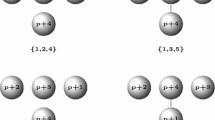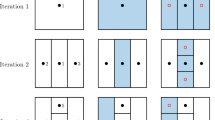Abstract
This paper is concerned with computational experimentation leading to the design of effective branch and bound algorithms for an important class of nonlinear integer programming problems, namely linearly constrained problems, which are used to model several real-world situations. The main contribution here is a study of the effect of node and branching variable selection and storage reduction strategies on overall computational effort for this class of problems, as well as the generation of a set of adequate test problems. Several node and branching variable strategies are compared in the context of a pure breadth-first enumeration, as well as in a special breadth and depth enumeration combination approach presented herein. Also, the effect of using updated pseudocosts is briefly addressed. Computational experience is presented on a set of eighteen suitably-sized nonlinear test problems, as well as on some random linear integer programs. Some of the new rules proposed are demonstrated to be significantly superior to previously suggested strategies; interestingly, even for linear integer programming problems.
Similar content being viewed by others
References
W.P. Adams and H.D. Sherali, A tight linearization and an algorithm for zero-one quadratic programming problems, Working Paper, Virginia Polytechnic Institute and State University, (1983b), Management Science, forthcoming.
E. Balas, An additive algorithm for solving linear programs with zero-one variables, Oper. Res. 13(1965)517.
E. Balas and J. Mazzola, Nonlinear 0–1 programming: I. Linearization techniques, Management Sciences Research Report No. 467(R) A(1980-l).
E. Balas and J. Mazzola, Nonlinear 0–1 programming: II. Domhance relations and algorithms, Management Sciences Research Report No. 467(R) A(1980-2).
M.L. Balinski, Integer programming methods, uses, computations, Management Science 12, 3(1965)253; see also Proc. Princeton Symp. on Mathematical Programming, ed. H.W. Kuhn (Princeton University Press, 1970) p. 199 and p. 267.
M. Benichou, J. Gauthier, P. Girodet, G. Hentges, G. Ribiere and D. Vincent, Experiments in mixed integer linear programming, Mathematical Programming 1(1971)76.
J. Boot and H. Theil, A procedure for integer maximization of a definite and quadratic function,Proc. 3rd IFORS Conf., Dunod, Paris (1964) p. 667.
R. Breu and C. Burdet, Branch and bound experiments in 0–1 programming, Math. Progr. Studies 2(1974)1.
M. Cooper, The use of dynamic programming methodology for the solution of a class of nonlinear programming problems, Naval Research Logistics Quarterly 27(1980)89.
M. Cooper, Survey of methods for pure nonlinear integer programming, Management Science (1981)353.
R. Dakin, A tree search algorithm for mixed integer programming problems, Computer Journal (1965)250.
E. Denardo and B. Fox, Shortest route methods: 2. Group knapsacks, expanded networks and branch and bound, Oper. Res. 27(1979)548.
J. Forrest, J. Hirst and J. Tomlin, Practical solution of large and complex integer programming problems with UMPIRE, Management Science 20(1973)736.
J.M. Gauthier and G. Ribiere, Experiments in mixed-integer linear programming using pseudo-costs, Mathematical Programming 12(1977)26.
A.M. Geoffrion, An improved implicit enumeration approach for integer programming, Oper. Res. 17, 3(1969)437.
A. Glankwahmdee, J. Liebman and G. Hogg, Unconstrained discrete nonlinear programming, Engineering Optimization 4(1979)95.
F. Glover, Improved linear integer programming formulations of nonlinear integer problems, Management Science 22(1975)455.
F. Glover and E. Woolsey, Converting the 0–1 polynomial programming problem to a 0–1 linear program, Oper. Res. 22, 1(1974)180.
O. Gupta, Branch and bound experiments in nonlinear integer programming, Ph.D. Diss., Purdue University (1980).
O. Gupta and A. Ravindran, Nonlinear integer programming and discrete optimization, in: Progress in Engineering Optimization, ed. R.W. Mayne and K.M. Ragsdell (ASME Publications, 1981) p. 27.
P. Hammer, Boolean elements in combinatorial optimization, in: Combinatorial Programming: Methods and Applications, ed. B. Roy (Reidel, Dordrecht, 1975) p. 67.
P. Hansen, Methods of nonlinear 0–1 programming, Ann. of Discrete Math. 5(1979)53.
W. Hock and K. Schittkowski, Test Examples for Nonlinear Programming Codes (Springer-Verlag, Berlin-Heidelberg-New York, 1981).
T. Ibaraki, The power of upper and lower bounding functions in branch and bound algorithms, J. Oper. Res. Soc. Japan 25, 3(1982)292.
M.D. Ivanchev, I.G. Mitev and N.I. Yanev, Realization of the branch and bound method for solving the general mixed-integer programming problem, USSR Computational Mathematics and Mathematical Physics 16, 3(1976)241.
E.L. Lawler and M.D. Bell, A method for solving discrete optimization problems, Oper. Res. 14(1966)1098.
E.L. Lehmann, Nonparametrics: Statistical Methods Based on Ranks (Holden-Day, 1975).
G. Lideor, Construction of nonlinear programming test problems with known solution characteristics,Evaluating Mathematical Programming Techniques, Proc, Boulder, Colorado, 1981 (Springer-Verlag, New York, 1982).
J. May and R. Smith, The definition and generation of geometrically random linear constraint sets,Evaluating Mathematical Programming Techniques, Proc, Boulder, Colorado, 1981 (Springer-Verlag, New York, 1982).
R. McBride and J. Yormark, An implicit enumeration algorithm for quadratic integer programming, Management Science 26, 3(1980)784.
B. Miller, On minimizing nonseparable functions on the integers with an inventory application, S1AM J. Appl. Math. 21(1971)166.
D.C. Myers, The design of branch and bound, Lagrangian relaxation and subgradient optimization startegies for mixed integer programming problems, Ph.D. Diss., Virginia Polytechnic Institute and State University, Virginia (1984).
G. Mitra, Investigation of some branch and bound strategies for the solution of mixed integer linear programs, Mathematical Programming 4(1973)155.
Y. Nakagawa, K. Nakashima and Y. Hattori, Optimal reliability allocation by branch and bound techniques, IEEE Trans. on Reliability 27(1978)31.
G. Oron, An algorithm for optimizing nonlinear constrained zero-one problems to improve waste water treatment, Engineering Optimization 4(1979)109.
C. Pegden and C. Peterson, An algorithm (GIPC2) for solving integer programming problems with separable nonlinear objective functions, Naval Research Logistics Quarterly 26(1978) 595.
J. Rosen and S. Suzuki, Construction of nonlinear programming test problems. Communications of the ACM 8(1965)113.
H. Salkin, Integer Programming (Addison Wesley, Reading Mass., 1975).
K. Schittkowski, Nonlinear Programming Codes Information, Tests, Performance (Springer-Verlag, Berlin-Heidelberg-New York, 1980).
K. Stecke, Nonlinear integer production planning problems, Management Science 29, 3(1983)273.
H. Taha, Integer Programming, Applications and Computations (Academic Press, New York, 1975).
J. Tomlin, Branch and bound methods for integer and nonconvex programming, in: Integer and Nonlinear Programming, ed. J. Abadie (North-Holland, Amsterdam, 1970) p. 437.
L. Watters, Reduction of integer polynomial programming problems to zero-one linear programming problems, Oper. Res. 15(1967)1171.
W. Wiede and G. Reklaitis, Design of multi-product processes using nonlinear integer programming, presented at ORSA/TIMS National Meeting, October 1981, Houston, Texas.
W. Zangwill, The convex simplex method, Management Science 14(1967)221.
Author information
Authors and Affiliations
Rights and permissions
About this article
Cite this article
Sherali, H.D., Myers, D.C. The design of branch and bound algorithms for a class of nonlinear integer programs. Ann Oper Res 5, 463–484 (1986). https://doi.org/10.1007/BF02739234
Issue Date:
DOI: https://doi.org/10.1007/BF02739234




